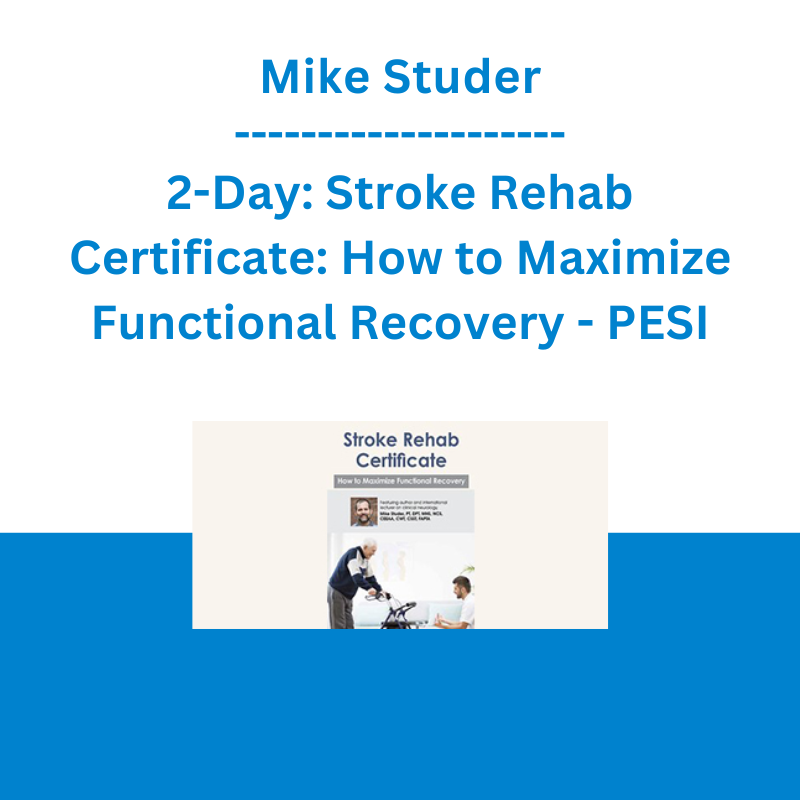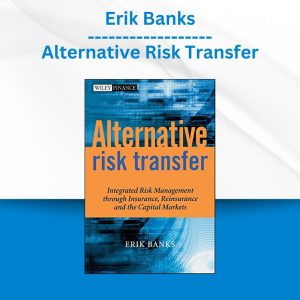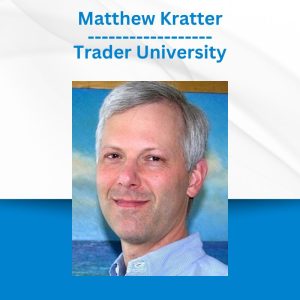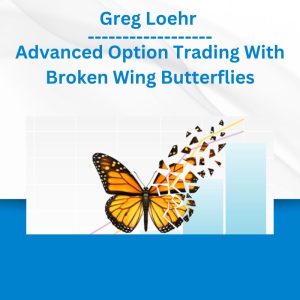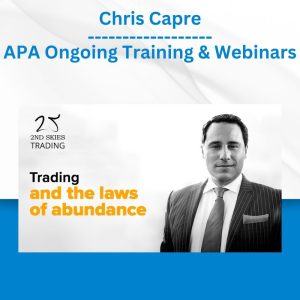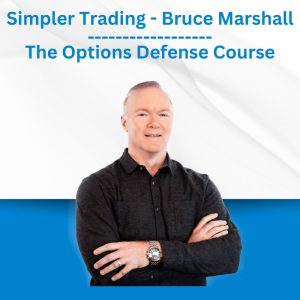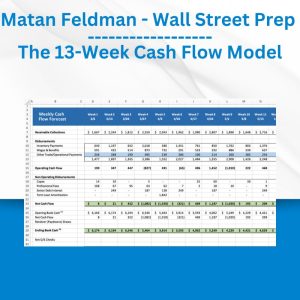*** Proof of Product ***
Exploring the Essential Features of “Mike Studer – 2-Day: Stroke Rehab Certificate: How to Maximize Functional Recovery – PESI”
Speaker: Mike Studer, PT, DPT, MHS, NCS, CEEAA, CWT, CSST, FAPTA
Duration: 11 Hours 57 Minutes
Format: Audio and Video
Copyright: Dec 01, 2022
Media Type: Digital Seminar
Description
After suffering a stroke, many emerge feeling trapped in a body that no longer works and fear the life they knew is gone. Furthermore, standard treatment strategies end with persistent long-term deficits and very basic gross motor skills at best. Your patient does not have to accept this fate and with the correct skillset, neither should you. Stroke rehabilitation does not have to be an either/or scenario – patients do not have to choose between walking or the ability to regain use of their arm!
While you may know techniques to facilitate movement in a flaccid UE and LE are similar:
- Do you know how to improve each individually as movement emerges?
- Are you able to easily identify methods to “force” movement and drive neuroplasticity in motor control and sensory recovery?
- Can we re-create automatic movement (without thinking)?
Don’t miss this opportunity to get answers to these questions and leave with a groundbreaking evidence-based skillset to achieve life changing results for your patients!
You are working with a 68-year-old patient 2 weeks after a stroke who is demonstrating minimal wrist and finger extension + sensory impairment in their affected arm. Can you help this person achieve full use of their arm to dress, carry items while walking, open doors and turn on faucets? After this course – your response should be a resounding…”Yes!”
Unfulfilled rehabilitation potential is one of the greatest losses a stroke patient may face. Don’t miss your opportunity to learn the skills needed to completely redefine what is possible for quality of life after a stroke.
Speaker
Mike Studer, PT, DPT, MHS, NCS, CEEAA, CWT, CSST, FAPTA
Mike Studer, PT, DPT, MHS, NCS, CEEAA, CWT, CSST, FAPTA has been a PT since 1991, a board certified in neurologic PT in 1995, and a private practice owner since 2005. Dr. Studer has been an invited speaker covering 50 states, 10 countries, and 4 continents speaking on topics ranging from cognition and psychology in rehabilitation, aging, stroke, motor learning, motivation in rehabilitation, balance, dizziness, neuropathy and Parkinson Disease. Dr. Studer is a co-founder and co-owner of Spark Rehabilitation and Wellness in Bend, OR. He is an adjunct professor at Oregon State University’s DPT program, where he leads the coursework on motor control. Mike has adjunct duties at several other DPT programs and assists the USC-led national network of neurologic PT residencies (Neuroconsortium) as well. Mike is the co-owner of Spark Rehabilitation and Wellness, a multidisciplinary Healthy Aging and Neurology rehabilitation clinic, also in Bend. In 2011, Mike was recognized as Clinician of the Year in the Neurologic and (in 2014) the Geriatric Academies of the APTA. He received the highest honor available in PT in 2020, being distinguished as a Catherine Worthingham Fellow of the APTA in 2020, joining a group of under 300 persons at the time for the history of the profession. Mike’s honors additionally reflect his service for Vice Presidency of the Academy of Neurologic PT, the Mercedes Weiss award for service to the Oregon chapter of APTA. He holds a trademark in dual task rehabilitation and has a patent pending on the same. Over his career, Mike has authored over 35 articles, 6 book chapters, and routinely has clinical research projects in affiliation with one of many universities. He is a consultant to Major League Baseball on the motor control of pitching and hitting. As a very fun and lighthearted note, Mike is the four time and current WR holder for the fastest underwater treadmill marathon, a mark that was set most recently in January 2022.
Speaker Disclosures:
Financial: Mike Studer is the co-founding member and co-owner of Spark Rehabilitation and Wellness and receives a speaking honorarium from SMARTFit. Mike Studer receives a speaking honorarium, recording royalties, and a consulting fee from PESI, Inc. All relevant financial relationships with ineligible organizations have been mitigated.
Non-financial: Mike Studer is a member of the American Physical Therapy Association, the Vestibular Disorders Association, and the Oregon Physical Therapy Association. He serves on the advisory board of Rehab Management and ADVANCE.
Objectives
- Analyze objective assessment data to gauge prognosis, treatment timeline and progression.
- Propose 3 techniques to successfully facilitate motion in the flaccid UE.
- Propose 3 techniques to successfully facilitate motion in the flaccid LE.
- Propose 3 applications of forced use therapy for UE sensory and motor recovery.
- Propose 3 applications of forced use therapy for LE motor recovery.
- Investigate evidence-based applications for post stroke gait training to achieve independent community ambulation.
- Demonstrate how to use dual task interference to promote automaticity in recovery of mobility.
- Demonstrate how to use dual task interference to promote automaticity in recovery of ADLs.
- Demonstrate effective documentation to support the use of dual task interference and demonstrate progress in divided attention.
- Discriminate spasticity vs tone, the functional implications, and the best evidence in management of each.
- Identify multidisciplinary coordination opportunities for incorporation of dual task interference to achieve team goals and patient outcomes.
- Identify objective interventions to rehabilitate impulse control with relevance for safety in mobility, MRADLs, ADLs, communication, and IADLs.
- Differentiate the 4 main modalities of distractions in clinical and real-world dual task (DT) applications.
- Analyze the three guiding principles of DT training.
- Investigate the physiology of attention and DT in normal, rehabilitative, and impaired conditions.
Outline
The neurophysiology of stroke
- Clinical decision-making impacting rehabilitation decisions
- Intensity, timing, frequency, and prognostic expectations – specific to stroke subtype
Improving prognosis after stroke:
- When you have seen one stroke…you have seen one
- Personalizing care by presentation
- Personalizing care by…person
- Debunking the myths of stroke: UE v. LE; timing; and “where gains come from”.
- Spasticity vs tone: An introduction to the difference and precursor to the treatments for each
Apply evidence to drive neuroplasticity with each presentation of paresis:
Upper Extremity
- Flaccid to “Found”
- Facilitate movement from a flaccid wrist or hand
- Found to Function
- Advance the UE from being available, to being “chosen”
- Force more recovery: CIMT and beyond –
- Techniques and tasks beyond a constraint
Apply evidence to drive neuroplasticity:
Lower Extremity & Fall Risk
- Tasks and activities to facilitate movement
- Develop neuromuscular resources
- Strength, endurance, motor control, and balance
- Forced use in action for LE recovery
- Incorporate evidence-based practice
Engage patients to optimize outcomes
- Apply the OPTIMAL theory of motor learning
- Autonomy, enhanced expectancies, and external focus
- Behavioral economics in rehabilitation
- Identify traits of bias, decision making, and choice architecture
- Facilitate compliance, intensity, and attendance
The future of stroke rehab
- Robotics
- Virtual reality (VR) and Brain Computer Interfacing (BCI)
- HIIT, HIGT, task-specific circuit training, and early mobilization (acute care)
- The resurgence of comprehensive outpatient rehabilitation facilities (CORFs)
Cognitive Rehabilitation: Dual task tolerance, function, impulse control and, awareness
- Background
- Review of learning outcomes
- Consequences of DT intolerance, reduced impulse control, and impaired awareness in your patients
Dual Task Rehabilitation: Constraining attentional resources to improve tolerance, function, and awareness
- Explaining how & why DT rehabilitation works
- Engaging your patients
- Emerging trends and current applications in screen and testing DT
Interventions for DT
- Applications in gait
- Multidisciplinary interventions
- Applications in balance, function, cognition, and fitness
- Case studies
Interventions for awareness
Interventions for impulse control
Documentation in cognitive rehabilitation post stroke: Attention, awareness, and impulse control
- Measurements and documentation tips for authorization/justification of care
Target Audience
- Physical Therapists
- Physical Therapist Assistants
- Occupational Therapists
- Occupational Therapy Assistants
- Speech and Language Pathologists
- Strength and Conditioning Specialists
- Nurses
- Nurse Practitioners
- Physician Assistants
- Physicians
Please see the full list of alternative group-buy courses available here: https://lunacourse.com/shop/

